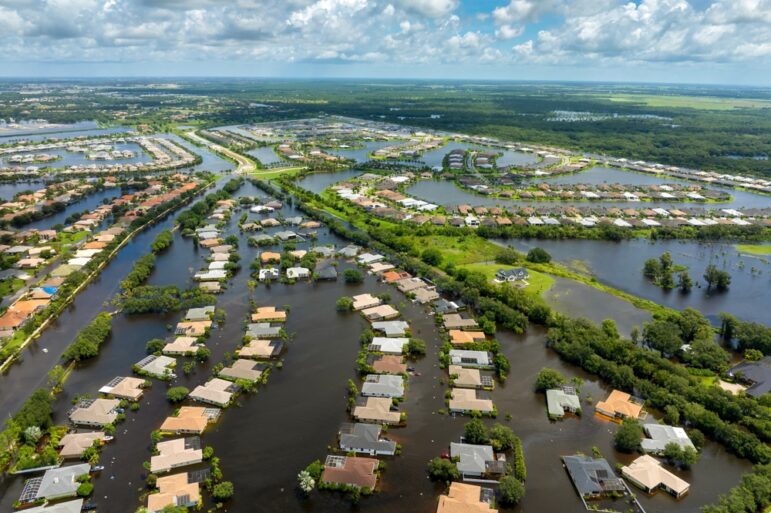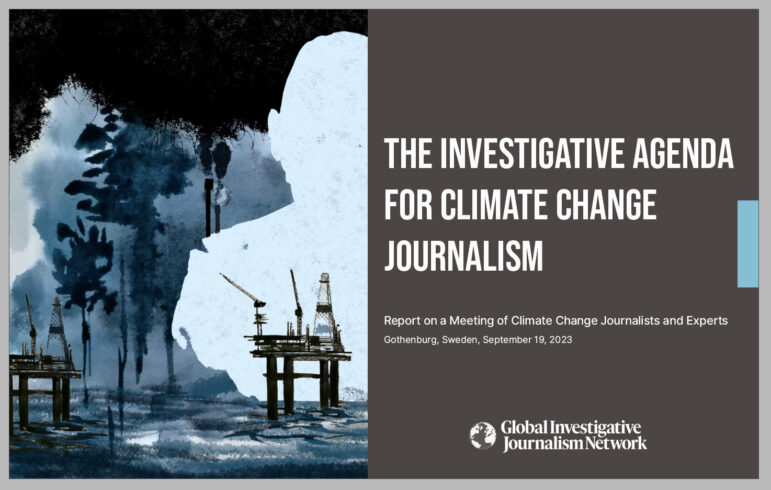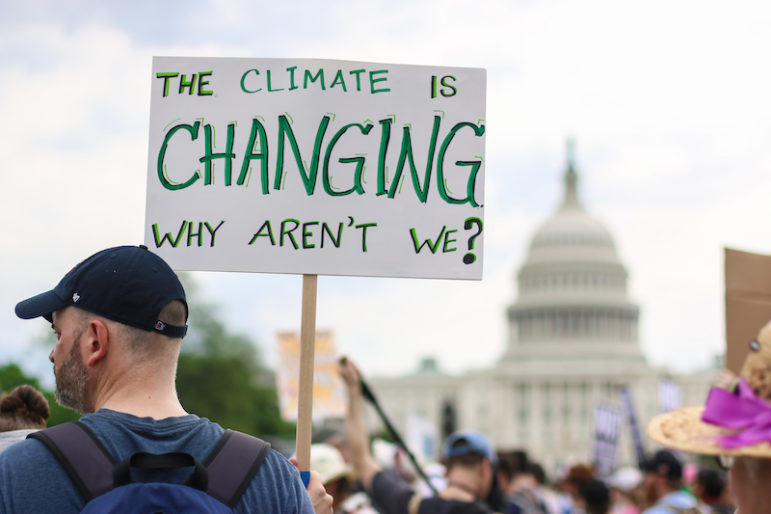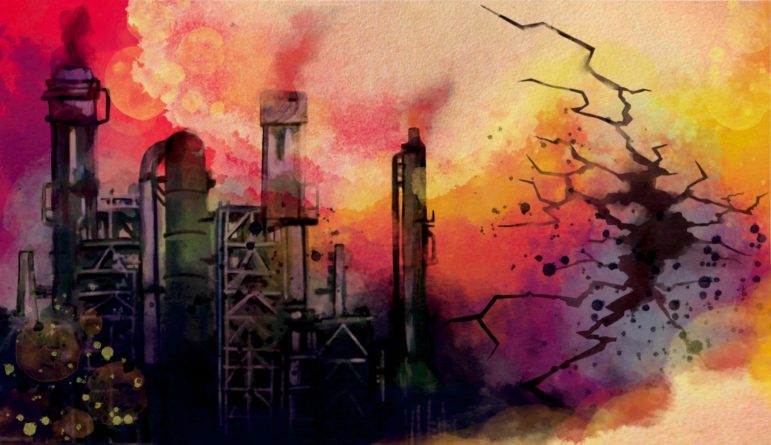

Image: Shutterstock
Tips to Investigate Climate Change Impacts in an Era of Science Denialism
Read this article in
After Hurricane Ida slammed into the southern coast of the US in 2021, AP reporter Michael Biesecker asked several environmental regulators for information about oil spills from hurricane damage to petrochemical facilities in the region. All of the agencies replied to say they were unaware of any spills.
As a climate reporter, Biesecker knew that research aircraft from the National Oceanic and Atmospheric Administration routinely overfly affected areas in the aftermath of hurricanes, so he immediately scrolled through the latest images posted to the NOAA website, looking for “rainbow sheen” associated with slicks. He quickly found two major spills in the Gulf of Mexico near the Louisiana coast, and effectively alerted national and local agencies — as well as the owner of the relevant refinery — to these disasters by emailing them screenshots. Then he broke the news that divers had identified a ruptured 30cm-diameter undersea pipe as the source of the offshore slick.
In 2023, he used satellite images and other investigative techniques to find the climate change-fueled causes of the lethal Maui wildfire in just four days — more than a year before government agencies reached the same conclusion.
Biesecker says it’s increasingly important for reporters to do their own incident investigations like these, in an era in which populist governments and oligarch-influenced sectors actively limit the gathering, storage, and dissemination of climate-related information.
At the other end of the impact chain, fellow climate reporters, such as Nina Elkadi, an investigative reporter at Sentient, say it’s also important to be more creative when interviewing victims, with many either influenced by disinformation, or uncomfortable with the topic, or fearful of repercussions, ranging from social media harassment to potential forced relocation.
Evidence of a miles-long post-hurricane oil spill in the Gulf of Mexico that the Associated Press identified from NOAA images and emailed to government agencies. Image: Screenshot, Associated Press, NOAA
Source Development Techniques for Climate-Related Stories
These were among a wealth of tools and techniques described at the recent Investigative Reporters and Editors conference in the US, which encouraged deeper digging on climate issues with several major sessions on the topic. In a panel on “Investigating Climate Change,” Biesecker was joined by Tracy Wholf, a senior coordinating producer of environmental coverage for CBS News and Stations, and Allison Prang, a freelance journalist who focuses on climate issues. And Elkadi’s panel on “Crafting Climate Investigations with Legal Documents” also featured Audrey Mei Yi Brown, an environmental health equity reporter at the San Francisco Public Press, and Luis Méndez González, an award-winning environmental investigative reporter for Puerto Rico’s Center for Investigative Journalism.
Both these panels noted that lawsuits — and the plaintiffs’ attorneys behind them — are a rich, underused source of climate-related stories, and that exhibits and footnotes often offer terrific detail on incidents of climate-related harm.
But Brown, who uses they/them pronouns, defined a common problem reporters encounter when engaging with the victims of impacts: “We are often interviewing people who don’t think they’re at the center of a climate story.”
As a result, several speakers suggested a surprising technique for identifying harms and disparities in incident response: chit-chat, and even gossip.
“Gossip may have a negative connotation in the social world, but in the world of environmental investigations, I think it’s one of the most important tools,” they said. “Gossiping with your sources about what’s going on in their small town; does this city councilor maybe have something to do with this polluting facility; you may hear that this or that is ‘probably’ going on. That’s where a lot of these story threads start for me, allowing that open dialogue before or after the interview.”
For instance, gossip with residents or union members can offer clues to a later discovery that toxic clean-ups are taking much longer to happen in marginalized communities within the same city.
Elkadi noted that it is sometimes advisable not to mention “climate change” at all in interviews with skeptical, non-expert sources.
“Farmers know more about the weather than most of us — it’s core to their job — and I find just talking about the weather is a really helpful strategy in learning about what is going on with their situation,” said Elkadi. “In many cases, saying “Oh, that’s because of climate change, right?’ can derail conversations for me. What sources say will speak for itself, and the context will speak for itself in the reporting. It can be better to frame it in terms of ‘Has this gotten worse over recent years?’”
For Biesecker, climate change is the major topic of our age — and newsrooms should therefore try to treat every news beat as a climate beat.
“It’s about accountability, so it’s really important to try to have an investigative mindset on climate issues,” he argued. “And climate cuts across the newsroom. So if you’re covering the school board, are they planning to install new HVAC systems to deal with warmer summers? If you’re covering city hall and they’re planning new roads, are they talking about roads being built higher than the old roads due to the risks of increased flooding?”
Biesecker offered the following tips to help power climate incident investigations:
-
Secure a channel to experts and officials. If you don’t already have a Premium LinkedIn account, fill in a simple online form to apply for a free, messaging-enabled LinkedIn for Journalists account to find experts and current and former officials. Freelancers can also apply, by including work samples on the form. “LinkedIn is your friend for source outreach,” he said. “A free premium LinkedIn for Journalists account lets you find and message the right people in this space.”
-
Learn the basic science of climate change and what is known. Biesecker recommends the book “What we know about climate change,” by MIT atmospheric scientist Kerry Emanuel. One reason to study up on basic science knowledge is that reporters need to be ready for public relations spin about the hazards of emissions and spills by corporations. As an example, Biesecker pointed to his investigation into arsenic contamination from coal ash pits, where the energy company spokesman claimed: “There’s more arsenic in a kid’s juice box than in these wells.” “Well, that’s perfectly true, if you don’t know the difference between inorganic and organic arsenic,” Biesecker explained. “There’s so much disinformation out there, so be very careful about what sources you look at.”
-
Find easy stories with the Carbon Mapper methane tool. While methane emissions are invisible to human eyes, this remarkable data portal identifies, measures, and maps major greenhouse emissions that are otherwise not noticed. Designed for use by researchers and journalists and run by a nonprofit group, it shows major methane and CO2 emissions based on sensing data from research aircraft, space satellites, and even the International Space Station. Biesecker says his team sometimes simply visits a site at the coordinates of the otherwise invisible plumes shown on the portal to see what’s going on beneath, and to find site ownership, for low-intensity climate stories — or uses it to check corporate zero-emissions claims. “Using this, we found that firms were vastly underreporting their emissions,” he noted. “This project started as a NASA program, and is now a privately funded nonprofit. They have satellites that circle the globe and see methane emissions. Methane is about 80 times more potent than carbon at heating the planet. Carbon Mapper lets you see where there are big plumes of this invisible gas going into the atmosphere.” It can be used in conjunction with other data tools, such as the United Nations Environment Programme’s International Methane Emissions Observatory. To check company claims about being “carbon neutral,” try the free OffsetsDB tool, which collects data about carbon offset credits and projects around the world. GIJN also has reporting guides on investigating methane as well as landfill methane emissions.
Carbon Mapper’s data portal page shows 25,000 major methane plumes around the globe. Image: Screenshot, Carbon Mapper
-
FOIA the FOIAs. “Many public agencies have a FOIA webpage where you can look up record requests filed previously. If there are competitors on the climate beat that are dominant and you’re new, look at what questions they’re asking.”
-
Always briefly include the “big-picture” climate change facts. Given the broad misinformation on this issue, Biesecker suggests that reporters relentlessly include the basic statistics — such as those showing that each year has been warmer than the previous in the past decade — no matter how narrow the climate issue in your story. “I try to preach that you should really drop these statistics into almost any story that involves climate, just to make the public aware of the level of warming going on.”
-
Watch the watchdogs. “We’re at a time when regulators are frequently not doing their jobs,” Biesecker cautioned. “They’re often very friendly to industry and polluters. Ask: ‘Are they favoring specific industries or corporations?’ Look at lobbying records; see who is trying to influence whom.” Also look for red flags for “regulatory capture” — where industries effectively gain control of a regulator. “If you’re in a place where the governor has appointed the former head of an electric utility to be the head of your environmental agency, that’s a warning flag. Look at the resumes of regulator appointees; look for conflicts of interest.”
-
Look for local databases compiled by climate reporters and researchers, and collaborate. Climate reporters tend to help each other, sometimes by open sourcing their own data. As an example, the panel pointed to the Renewable Rejection Database, which has been compiled by climate writer Robert Bryce, and which shows the restrictions and rejections of wind and solar projects in North America since 2015.
-
Do a “pencil check.” “I always like to print everything out pre-publication, and go through each and every fact,” Biesecker said. “If you make one little error in a story, believe me, hostile firms and agencies will inflate those and use them against you. Bulletproof yourself against potential blowback: you’re going to be going up against very well-funded organizations that are polluters, and pollution is profitable.”
-
Turn online sources into human voices. “The data is going to allow you to find people, and people are what make stories work,” Biesecker added. “People read stories about other people. They may not read stories about a climate issue, but they will read about someone struggling with that issue — especially if you can show the reader might be similarly impacted in future. Paint pictures with words so your reader sees what you see on the ground.”
Source Reluctance Beyond Climate Skepticism
González told attendees that there are numerous reasons beyond climate skepticism why people vulnerable to climate impacts can be reluctant to speak.
“Reporting on the connection between rural infrastructure problems and climate change in the southeast of Puerto Rico, I found it was extremely hard to talk to people about the problem,” he said. “They feared that talking about sea level rise and coastal erosion might ultimately cause them to have to leave their homes, because the permanent solution being discussed by government and experts was relocation to other places. So you need to be sensitive to these communities.”
Even talking to officials is increasingly difficult in populist-run nations. Brown says they have had to phrase questions differently to regulators under the Trump administration, for reasons far beyond the government’s skepticism around human-caused climate change.
“Officials at the EPA told me they can no longer discuss anything related to DEI (diversity, equity, and inclusion) or inequities — and I report on equity!” they added. “In order to do those interviews, I’m still asking the same content, but I am changing the way I’m phrasing the question.”
Wholf noted that it is often necessary to “peg” climate stories to popular subjects such as sports, entertainment, or cultural events to highlight the issue for disengaged audiences, and to persuade editors — and especially TV news producers — to run prominent investigations. So for a story on greenwashing, for instance, her team found data showing a high proportion of fossil fuels advertising in college sports in the US, and hyper-popular events such as the March Madness basketball tournament.
“Or you can look at something like Christmas trees — there are a lot of climate issues involving Christmas trees, and that will make it even onto morning television, I guarantee you,” said Wholf. “Don’t be afraid to find those compelling story markers.”
 Rowan Philp is GIJN’s global reporter and impact editor. A former chief reporter for South Africa’s Sunday Times, he has reported on news, politics, corruption, and conflict from more than two dozen countries around the world, and has also served as an assignments editor for newsrooms in the UK, US, and Africa.
Rowan Philp is GIJN’s global reporter and impact editor. A former chief reporter for South Africa’s Sunday Times, he has reported on news, politics, corruption, and conflict from more than two dozen countries around the world, and has also served as an assignments editor for newsrooms in the UK, US, and Africa.









